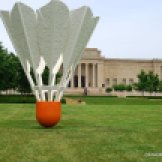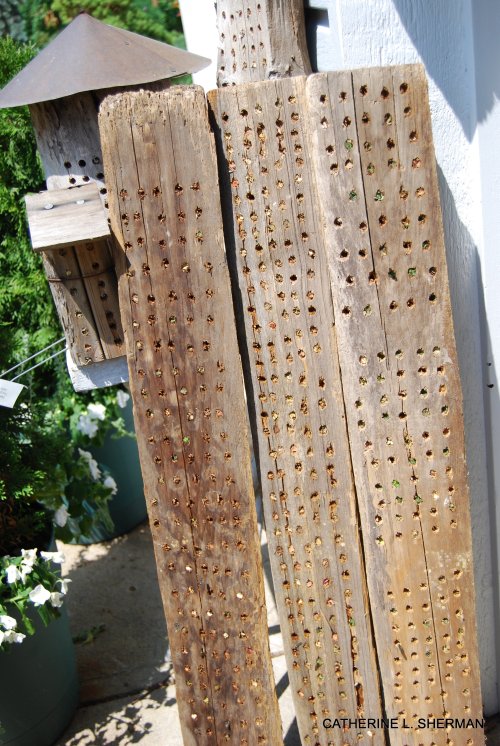August 26, 2009 · 6:59 pm

Wedding parties often arrive on the south lawn of the Nelson-Atkins Museum of Art to be photographed in front of the shuttlecocks. In fact, I don’t think you’re officially married in Kansas City until you make this ritual visit with your bridesmaids and groomsmen. If you elope, better show up here, too.
Fifteen years ago, four giant shuttlecocks landed on the grounds of the Nelson-Atkins Museum of Art in Kansas City, Missouri. Designed by sculptors Claes Oldenburg and Coosje van Bruggen, the shuttlecocks received a mixed reception when they were first installed, but now they’ve become Kansas City icons. They add a whimsical touch to the classical exterior of the Nelson-Atkins. The contemporary glass Bloch Building (and it does look like glass blocks) addition to the east further lightens the mood. The Bloch contains the museum’s contemporary and African collections nad provide access to the outdoor sculpture garden, which features the works of many artists, including Henry Moore.

The shuttlecocks are always ready to pose. Here’s my friend Jan from California in her first visit to the Nelson-Atkins. Check out her blog by left clicking on this photo. (But only after you’ve checked out all of my photos!)
Bridal parties swarm around the shuttlecocks for wedding photos, impromptu soccer games arise among the sculptures, picnickers settle near them. In the beginning, many people thought (and wished) the shuttlecocks were a temporary exhibition, but Kansas Citians aren’t letting go now.
Inside the Bloch are smaller Claes Oldenburg sculptures, (small is a relative term) including a large orange vinyl light switch that slumps from the wall. A docent told me that Oldenburg’s first wife did the actual construction. I need to find out more about her!

Another wedding! Maybe you didn’t believe me when I said you weren’t married unless you stood in front of a shuttlecock…..A Kansas City Star photographer was shooting this bride and groom for a feature on the shuttlecocks when I took this photograph. They weren’t the only wedding party there that day.

Here’s the south side of the Nelson-Atkins Museum of Art, which from this perspective looks small compared with the giant shuttlecock.

Everyone enjoys the shuttlecocks.


A shuttlecock adorns the front of the Nelson-Atkins Museum of Art in this dramatic night view.

This shuttlecock looks lonely in winter.

A young visitor surveys the south lawn of the Nelson-Atkins Museum with one of Rodin’s The Thinker and two shuttlecocks in the view.
ABOUT CLAES OLDENBURG AND COOSJE VAN BRUGGEN
(From http://nelson-atkins.org) Claes Oldenburg and Coosje van Bruggen are artists/collaborators and husband and wife. In the 1960s, Oldenburg became one of America’s famous Pop artists. He is also known for creating the first soft sculptures made of fabric, many of which were foodstuffs—slices of cake, ice cream cones and hamburgers that are staples of daily life in America. As his repertoire grew, Oldenburg created typewriters, electric fans and toilets. The Museum’s Switches Sketch (1964) and Soft Saxophone, Scale B (1992) are classic examples of Oldenburg’s soft sculptures of familiar objects.
Oldenburg and van Bruggen’s first collaboration was in 1976, when the sculptures Trowel I (1971–1976) in Otterlo, The Netherlands, and Trowel II (1976) in Purchase, New York, were commissioned. The artists married in 1977 and have since executed more than 40 large-scale sculptures worldwide. Whimsical works like the soft sculptures are based on everyday objects from popular culture. By making ordinary objects the focus of their art rather than depicting more traditional, heroic and commemorative subjects, they challenged conventions and reinvigorated the history of sculpture.
Created on a monumental scale, works such as Clothespin (1976) in Philadelphia; Spoonbridge and Cherry (1988) at the Walker Art Center in Minneapolis; Typewriter Eraser, Scale X (1999) at the National Gallery of Art Sculpture Garden in Washington, D.C. and Shuttlecocks (1994) at The Nelson-Atkins Museum of Art continue to delight and surprise visitors.
Oldenburg was born in 1929 in Stockholm, Sweden. Van Bruggen was born in 1942 in Groningen, The Netherlands. She died in 2009.
To see larger versions of these photos, click on the thumbnails.

Climbing on the shuttlecocks isn’t allowed, but some people can’t resist. It’s better than the monkey bars! I’ve read that a motion detector is tripped when people climb on, and a voice on a PA system will warn art lovers to stand clear. I’ve never heard this warning, though.

Shuttlecock in winter.

You can see the back of the Nelson-Atkins Museum of Art, which from this perspective looks small compared with the giant shuttlecock.

A Kansas City Star photographer was shooting this bride and groom for a feature on the shuttlecocks when I took this photograph.

Wedding parties often arrive on the front lawn of the Nelson-Atkins Museum of art to be photographed in front of the shuttlecocks. In fact, I don’t think you’re officially married in Kansas CIty until you make this ritual visit with your bridesmaids and groomsmen.


























